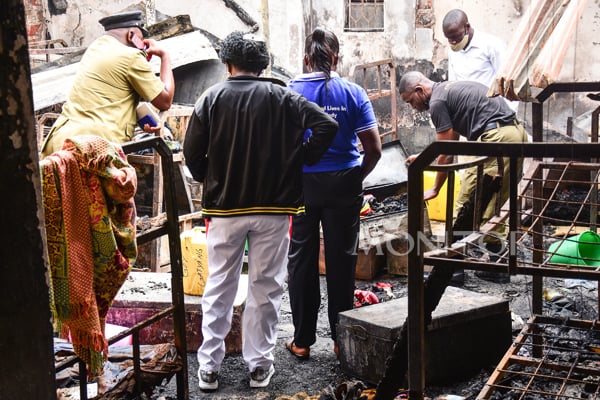History of Uganda Railway

Lady Florence Preston drives the last sleeper key at the edge of Lake Victoria on December 20, 1901, to mark the end of the Uganda Railway Project. PHOTO COURTESY OF HENRY LUBEGA
What you need to know:
This week, we take you back to one of the biggest construction projects the British government undertook in the sub-Saharan Africa during the colonial days, the Uganda Railway.
Mogo wa’Kebiro, a Gikuyu medicine man, once prophesied that colonialists would one day bring an iron snake with as many legs as monyongoro (centipede), and that this iron snake would spit fire and would stretch from the big water in the east to another big water in the west of the Gikuyu country.
This week, we take you back to one of the biggest construction projects the British government undertook in the sub-Saharan Africa during the colonial days, the Uganda Railway.
The idea of having a railway from the coast was mainly to have an effective control of events around River Nile’s source in Uganda. The Uganda Railway, as it came to be known, was more of a military and political move than commercial as the British wanted the natives to believe. The control of the Nile was of major importance to the British in Uganda.
At the time of the scramble for Africa during the 1880s, influential British politicians were worried that the land surrounding the Nile may fall in the hands of British enemies, and this would affect Egypt. Writing in the book The Lunatic Express, Charles Miller said: “Whatever power dominates Uganda masters the Nile, the masters of the Nile rules Egypt, the ruler of Egypt holds the Suez Canal.”
The Suez Canal was the trade gateway between Europe and the rest of the world. With their interests clearly mapped out, British politicians introduced a bill in their parliament, according to the Parliament Africa papers in the archives of the British parliament.
In 1896, they passed an act called the Uganda Railways Act of 1896 which paved way for the construction of the railway.
Early History
Towards the end of 1891, under the directions of Her Majesty’s government, orders were given to examine and report on the possibility of having a railway to connect Mombasa with the Victoria Nyanza (as Lake Victoria was called then).
The first report on the possible route was released in 1893 titled Mombasa –Lake Victoria railway survey, according to parliament paper C-7025 of 1893. The report estimated the total mileage of the line to be 657 miles.
Writing the report, Maj MacDonald estimated the initial cost of a partial blast of 3ft 6inches to cost £3,400 (Shs15.3m in today’s exchange rate) per mile, bringing the total cost to slightly more than £2m (Shs9b). MacDonald’s reconnaissance team presented their findings, according to Africa report number 6 of 1901, though it was not adopted as the guide for the project.
After the report was found not satisfactory to Her Majesty’s government, another report was presented by Sir Guilford Molesworth on May 1, 1891, and it was not until 1895 that a government committee for the Uganda Railway Project was formed. It comprised Sir Percy Anderson, Sir Montagu F. Ommammey, Sir Alexder M. Rendel, Sir John Kirk and Sir Henry Colville.
The five-man committee studied the two reports of MacDonald and that of Molesworth before making recommendations to the government.
According to parliament paper number C78833 of 1895, the five-man committee presented a report recommending the construction of an exceptionally high and moderately equipped railway.
The funds for the project were approved in the Uganda Railway Act of 1896, and in August 1895, a vote was made in the British parliament for the start of the construction of the Uganda Railway and a three-man team to oversee the work was put in place.
The team was made up of Sir Percy Anderson as its chairman. Others were Sir Mongatu Ommanney and Sir G. L. Ryder.
However, to have the kind of railway recommended in the new proposal required importing labour. According to the report, the project had to import 7,500 skilled labourers mainly from India and another 20,000 unskilled labourers.
However along the way, by 1899, there was famine in the hinterland of the East African Colony (Kenya) which made the availability of the native labour hard.
The construction
On December 11, 1895, George Whitehouse, the chief engineer of the project, and his team arrived at Mombasa ready to start the job, which began in earnest in January of the following year.
On May 30, 1896, the official laying of the first rail near Kilindini was done. That same month Class ‘A’ second-hand locomotives, which had been imported from India, also arrived at the port ready to start piling the laid rails.
Before the official commencement of the construction, there was debate over the gauge of the rail. Different construction companies which bid to carry out the construction presented different gauges, before the British parliament decided that the Uganda Railway will be built directly under the control of the British government.
The construction companies included Pauling and Company, Messrs King, Barraud and Burnless –with vast experience of railway construction in India and proposed a 3ft 6inch gauge. Boustead, Ridley and Company of Zanzibar proposed a 2ft 6inch line.
It was, however, decided that because of the political and military importance, the proposed Uganda Railway have a 3ft 6inch gauge line.
To emphasise its political and military importance, during a meeting between the project’s chief engineer and then British premier Lord Salisbury in October 1897, Salisbury told Whitehouse: “The line should be pushed on as soon as possible. It’s a political necessity that we should get to the lake (Victoria) as soon as possible as the French were doing something on the Nile.”
What Salisbury was referring to was the Fashodah incident in the Sudan, when France and Britain almost went to war.
As the construction progressed, the demand for locomotives and wagons increased. Arrangements were made to have standard ‘F’ locomotives for the meter gauge rail from the India State Rail. Unfortunately, the Indian government was not willing to let go of their latest locomotives. Instead, they released the 1879 standard ‘F’ locomotives.
Writing in his diary, Whitehouse said: “I managed to get 22 out-dated locomotives from India, many of which were unable to cope with the demanding conditions of the Uganda Railway Project.” To fuel the locomotives, the project management relied on the abundance of wood fuel, most especially the eucalyptus trees.
In May 1899, the railway reached a site 326km from the coast; this became its major depot and later evolved into the capital city Nairobi. In the book The Genesis of Kenya, Colony, based on the diaries of Ronald Preston, one of the project engineers, gave the conditions of what was then known as Nyrobi, were like.
“Moving further towards Nairobi, malaria and black water fever took their toll until the railhead climbed high enough to go out of range of the mosquitoes,” he said.
The lions were not done after the railway passed Tsavo National Park. On June 6, 1900, the superintendent, Charles Ryall, was pulled out of his wagon and eaten by the lions. That wagon became a prominent feature in the movie The Permanent Way, shot in the 1960’s about the construction of the Uganda Railway.
In 1899, the Uganda Railway construction committee moved its head offices from Kilindini in Mombasa to Nairobi and this set the foundation for the administration offices of the East African Protectorate, giving birth to the capital Nairobi.
From Nairobi, it went through the rift valley, according to Preston’s records. This was one of the most difficult sections after the man-eaters in Tsavo.
“After the climb from Nairobi to the top of the eastern escarpment of the rift…the alignment had to fall 1,500 feet to the floor of the valley. The route down this escarpment was a very difficult one,” Preston wrote.
“Track laying on the floor of the rift valley was much easier on the main line, my worker men, under favourable conditions, would link 5,200ft of line in a day.”
Beyond Nakuru to what was known as Port Florence (Later Kisumu), the track went through difficult territory of the Mau escarpment which was very cold.
The commissioner of Uganda noted: “The construction team suffered badly from wet and cold conditions in the highlands of the Mau, and then from the tropical fevers on the humid, swampy, flat lands of Kavirondo, approaching Lake Victoria.”
On December 19, 1901, engineer Preston and his team laid a record length of 10,400ft of line ending at Port Florence (Kisumu) on Lake Victoria. The following day project chief engineer Whitehouse accompanied the Commission of the East African protectorate (Kenya), Sir Charles Elliot, to witness the end of the project.
A telegram was sent to King Edward VII and premier Salisbury announcing the completion of the project.
According to Henry Guston’s presentation to the Science Museum of London on December 11, 2002, Preston recorded in his diary that at 4pm on December 20, 1901, his wife Florence drove the last sleeper key at the edge of the lake to commemorate the completion of the job.
In September 1903, the Uganda Railway committee, which had been created to oversee the construction, was dissolved.
The first railway to Uganda
The first railway into Uganda proper was extended in the mid-1920s from Nakuru to Soroti through Tororo in 1929 before coming down to Jinja through Namasagali.
The line to Kampala across the Nile bridge at Jinja was done by the Nicholson brothers. Ramsay Nicholson and his young brother Pearce supervised the construction of the railway bridge in 1926.
The railway finally reached Kampala in 1931 before being extended to Kasese in western Uganda where it reached in 1956 and the northern line reaching Arua in 1964.
Rise and fall
Uganda Railways Corporation (URC) was a government parastatal formed after the collapse of the East African Community (EAC). Before the collapse of the EAC, the Uganda Railway was part of the East African Railways, a body formed by the British to manage the network after laying other lines connecting to the main route.
However, with the breakup of the community, the East African Railways and Harbour Authority was no more and it gave birth to the Uganda Railways Corporation in 1977.
During Uganda Railways glorious days, it covered 190km from Kampala to the Kenyan border and 8km between Kampala and Port Bell.
From Kampala it went to Kasese in western Uganda, and its northern route went through Tororo, Mbale, Soroti, Pakwach, Lira and ended in Gulu Town, covering 1,266km in Uganda alone.
It was in 1989 that the last train to Kasese made its journey, 33 years after its maiden trip and 58 years since it had reached Kampala.
Financial and human costs
The total cost of the line from Mombasa was £5.5m (Shs24.7b) with each mile costing £9,422 (Shs42m).
In terms of human resource, by March 1901, more than 20,000 men from India and 2,500 from East Africa had worked on the railway. About 6,500 were badly wounded and became incapacitated, while 2,500 died mainly from tropical disease.
The number of Africans who were injured or died while working on the project was not recorded.
By the time the rail reached Port Florence (Kisumu), the area was still part of Uganda. However, in April 1902, Port Florence, during the redrawing of the border between the two British protectorates, was transferred westwards and became part of present day Kenya.
This transfer of Ugandan territory made the entire Uganda Railway to become Kenyan owned.




